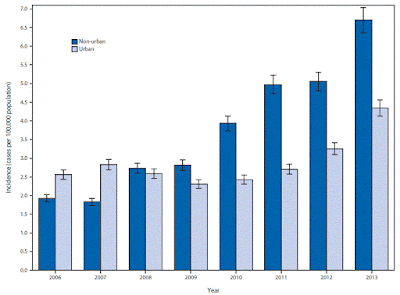The number of hepatitis B cases in Kentucky, Tennessee and West Virginia increased 114 percent from 2009-2013, while hepatitis B cases remained stable nationally during the same time period, says a study released Thursday by the Centers for Disease Control and Prevention. The study, which cites intravenous drug use in Appalachia for the rise in cases—rates were highest among non-Hispanic whites ages 30-39—found that 42 percent of cases occurred in rural areas in both the national study and in the three targeted states. From 2006-2013 a total of 3.305 hepatitis B cases were reported in the three states, with numbers increasing 20 percent from 2009 to 2010 and 114 percent from 2009-2013.
Hepatitis B, a potentially serious liver infection, "spreads when someone comes in contact with blood, semen or other bodily fluids from an infected person," Laura Ungar reports for USA Today. "For some patients, it’s a short-term illness, but others develop long-term, chronic infections. About 2.2 million Americans live with chronic hepatitis B, which can lead to cirrhosis or liver cancer."
"Unlike hepatitis C, which is caused by a similar virus and can be spread in similar ways, hepatitis B can be prevented with a vaccine, which is recommended for infants at birth, people with multiple sex partners and injection drug users, among others," Ungar writes. "But federal surveys show that hepatitis B vaccination coverage is low among adults nationally." (CDC graphic: Hepatitis B infection in Kentucky, Tennessee and West Virginia from 2006-2013)

No comments:
Post a Comment